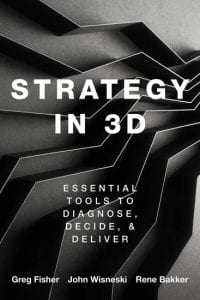 BLOOMINGTON, Ind. – In the introduction to his new book, Greg Fisher and his co-authors note that strategy used to be the domain of only those at the very top of an organization. Many would attend management retreats and forget what was discussed soon afterward, much like unfulfilled New Year’s resolutions.
BLOOMINGTON, Ind. – In the introduction to his new book, Greg Fisher and his co-authors note that strategy used to be the domain of only those at the very top of an organization. Many would attend management retreats and forget what was discussed soon afterward, much like unfulfilled New Year’s resolutions.
“It used to be that strategy happened at off-site retreats, often coupled with golf, cigars and scotch. It used to be that strategy was only discussed as part of an annual planning cycle … was about grand, long-term plans that stretched way into the future,” they wrote. “Strategy was largely cerebral.”
Fisher, the Larry and Barbara Sharpf Professor and an associate professor of entrepreneurship at the IU Kelley School of Business, says those days are over. Even before the Covid-19 pandemic began seemingly disrupting every aspect of life, including business processes, the rapid pace of social change meant that companies could no longer wait or slowly adjust.
His book, “Strategy in 3D: Essential Tools to Diagnose, Decide & Deliver (Oxford University Press),” co-authored with two former Kelley School faculty members, presents insights into how companies can broaden and include more people in the strategic process.
 “Anyone with career ambition in the business world needs to become a strategist. We hope this book will serve as a useful resource for everyone willing to take that leap,” he wrote along with John Wisneski of Arizona State University’s W.P. Carrey School of Business and Rene Bakker of Rotterdam School of Management at Erasmus University.
“Anyone with career ambition in the business world needs to become a strategist. We hope this book will serve as a useful resource for everyone willing to take that leap,” he wrote along with John Wisneski of Arizona State University’s W.P. Carrey School of Business and Rene Bakker of Rotterdam School of Management at Erasmus University.
The first section of the book discusses strategic concepts and ideas and how they can be enacted in different ways and at different levels of an organization. Then they discuss the “three elements that are central to being strategic within a business – the 3Ds of diagnose, decide and deliver.” The second section outlines tools that should be part of any manager’s strategy toolbox.
The authors see strategy as being about diagnosing a wide array of complex issues or opportunities facing organizations, deciding on solutions to address those challenges or opportunities and then taking action. But the process of forming such strategies is messy.
“There are no hard-and-fast rules when it comes to applying tools in tandem,” they note in the book’s conclusion. “What does stand out, though, is that making combinations that ‘click’ with the specific problem in focus adds more value than simply adding tools in isolation.”
The book’s 218 pages cover a great deal, but here are three important takeaways from Fisher, Wisneski and Bakker:
- Let the problem define the parameters – Preconceived preferences for certain tools or frameworks offer fewer useful insights than the application of tools developed to address specific issues. “In other words, start from the problem or question you face,” they said.
- Combine strategic tools that offer complementary insights – It makes sense to select tools that will investigate different sides of a problem, “making sure no stone is left unturned.”
- It makes sense to often include at least one external and internal strategic tool in tandem. “We want to know generally whether this new market is attractive, but the more important question is whether the market is also attractive for us,” they said.
“Strategists are everywhere,” Fisher and his co-authors write. “We are aligned in our dismissal of the view of the chief executive as the almighty, all-knowing strategy designer.”
Brilliant book, Greg and co-authors. This should be on the must read list for all executive teams. I couldn’t agree more with your aligned views on the all-knowing CEO – those days are long gone. And this could not be more true than in this endemic world in which we live and work. Inclusive teams (race, gender, class, age, sexual identites, religion, cultures among others) created from resources across the organisation yield broader thinking , better solutions and more sustainable businesses.
Shireen Chengadu